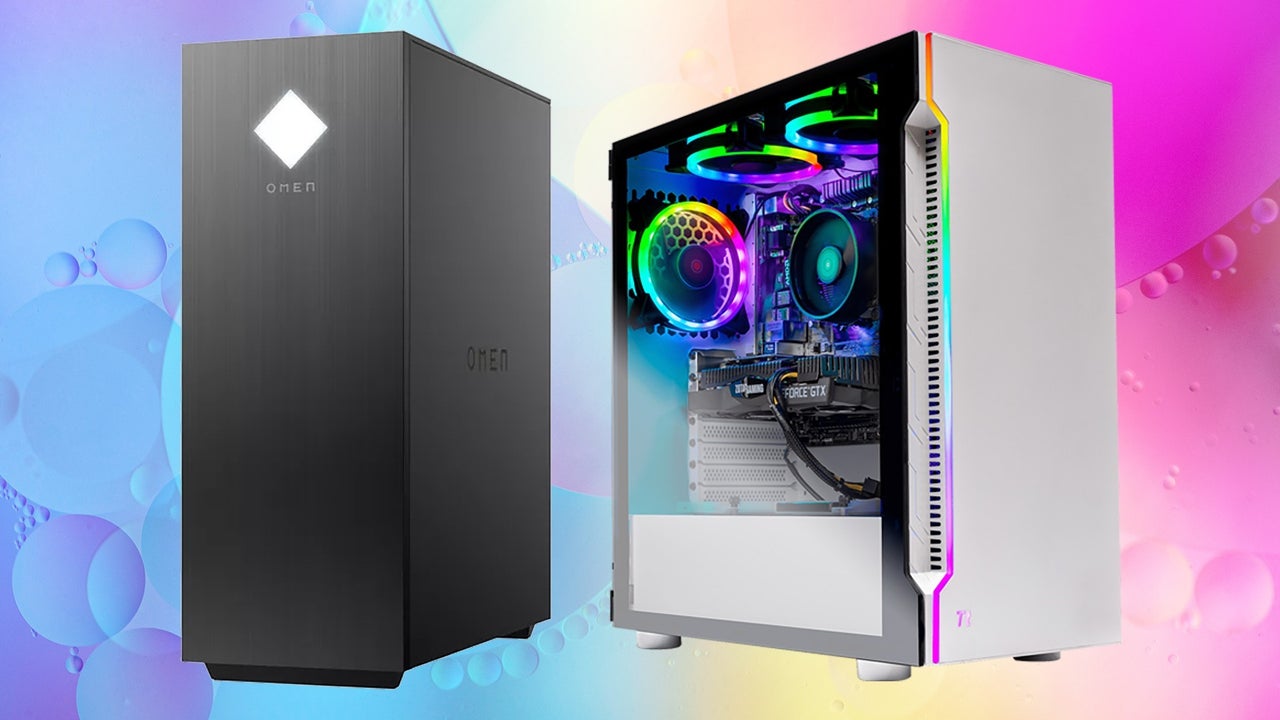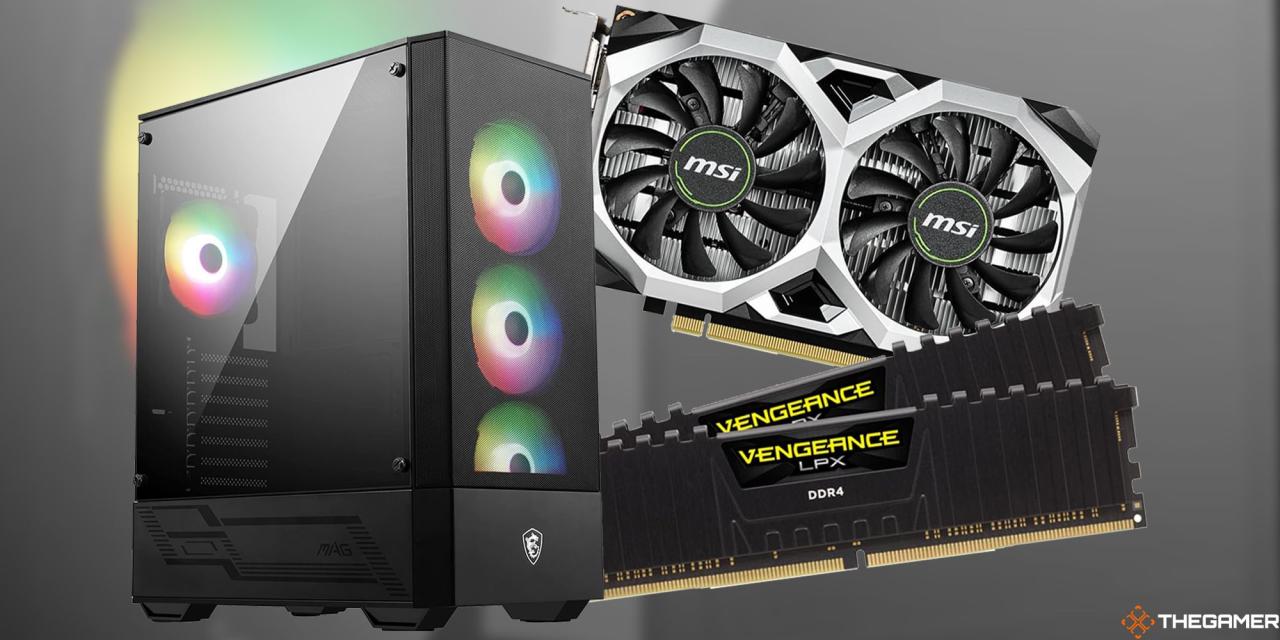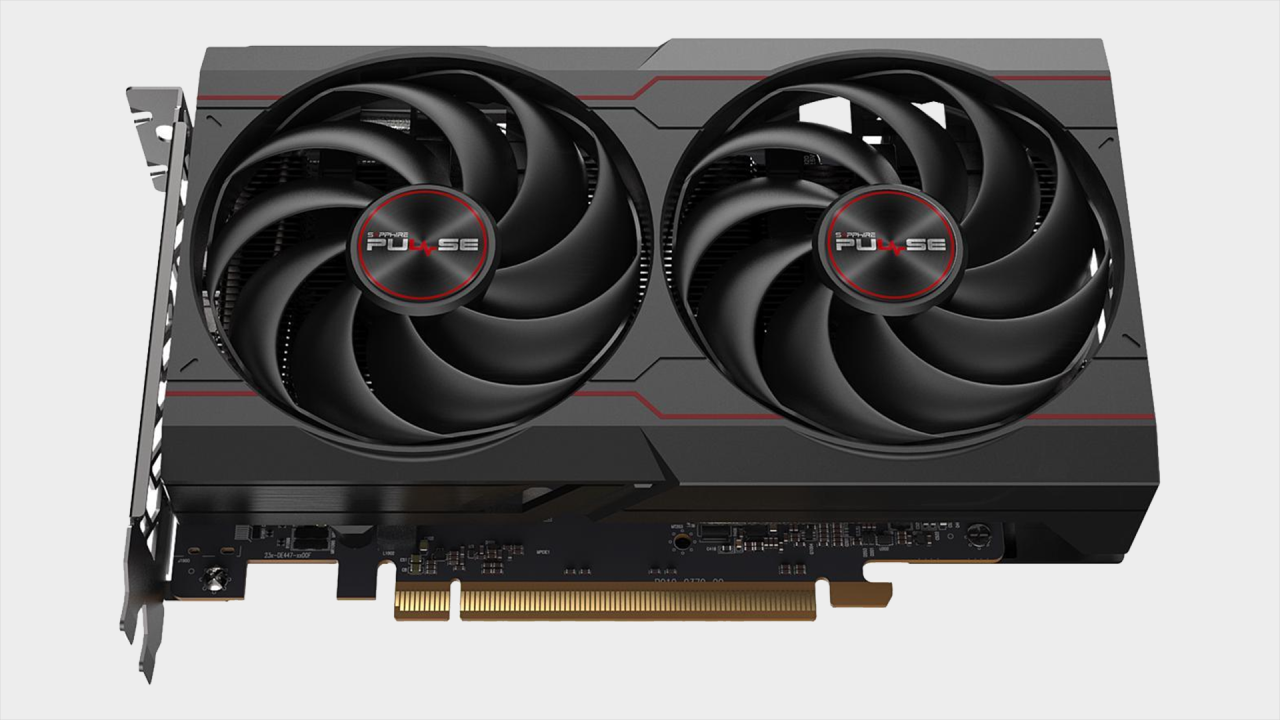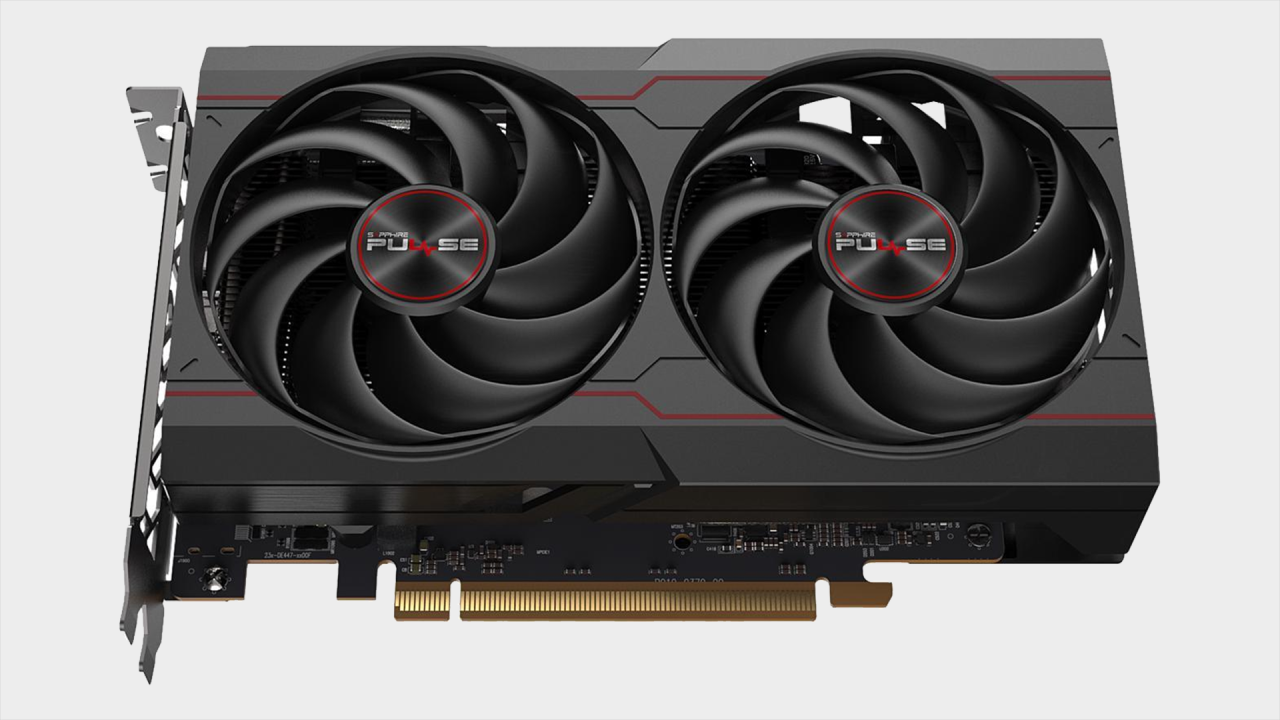Budget gaming PCs offer a fantastic way to experience the latest games without breaking the bank. This guide dives deep into the world of affordable gaming, exploring everything from component selection to optimizing performance, and even considering pre-built alternatives. We’ll help you navigate the trade-offs between price and performance to ensure you get the most out of your gaming experience.
Understanding the diverse needs of gamers and the varying levels of performance available, this guide will equip you with the knowledge to choose a configuration that aligns with your budget and gaming aspirations. Whether you’re a seasoned PC builder or a complete beginner, this guide provides a clear roadmap to assembling or selecting a budget gaming PC that meets your needs.
Introduction to Budget Gaming PCs

Budget gaming PCs cater to a broad audience, from students and entry-level gamers to those seeking a cost-effective way to enjoy their favorite games. These systems prioritize affordability over top-tier performance, making them an attractive option for those looking to experience gaming without breaking the bank. They often feature a balance of components that deliver satisfactory performance for a range of titles, though they may fall short of the graphical fidelity and frame rates offered by high-end PCs.These PCs represent a significant trade-off compared to high-end systems.
Components may be less powerful, leading to reduced graphical fidelity and lower frame rates, particularly in demanding titles. However, the price difference allows users to get into the hobby of gaming without a large upfront investment, making them an ideal starting point. The components and features are carefully chosen to balance performance, quality, and price.
Common Component Characteristics
Budget gaming PCs frequently utilize mid-range or entry-level graphics cards, processors, and RAM. These components offer a compromise between cost and performance, ensuring a functional gaming experience. Storage solutions, often solid-state drives (SSDs) for faster boot times and loading speeds, or hard disk drives (HDDs) for increased capacity, are selected based on the desired storage space and budget.
Power supplies are typically sized to handle the demands of the chosen components, maintaining system stability while minimizing cost.
Balancing Performance, Features, and Affordability
A crucial aspect of budget gaming PCs is the careful balancing of performance, features, and affordability. Users need to make informed decisions regarding component choices, considering the expected gaming experience. Choosing a balance between the cost of each component and its performance capability is key. Lower-end components, while cheaper, might limit performance, especially in newer or graphically demanding games.
A compromise between high-end features and a lower budget is often necessary.
Configuration Comparison
| Configuration | Processor | Graphics Card | RAM | Storage | Estimated Price Range |
|---|---|---|---|---|---|
| Entry-Level | Intel Core i3 or AMD Ryzen 3 | Nvidia GeForce GTX 1650 or AMD Radeon RX 6500 XT | 8 GB DDR4 | 256 GB SSD | $500-$700 |
| Mid-Range | Intel Core i5 or AMD Ryzen 5 | Nvidia GeForce RTX 3050 or AMD Radeon RX 6600 | 16 GB DDR4 or DDR5 | 512 GB SSD | $700-$1000 |
| High-End (sometimes considered Budget-friendly High-End) | Intel Core i7 or AMD Ryzen 7 | Nvidia GeForce RTX 3060 or AMD Radeon RX 6700 | 16 GB DDR4 or DDR5 | 1 TB SSD | $1000+ |
This table illustrates a simplified comparison. The price range is an estimate and can vary depending on the specific components, retailer, and current market conditions. Factors such as the particular model of the components, availability, and regional variations will impact the exact price.
Component Selection for Budget PCs

Building a budget gaming PC requires careful consideration of each component. Prioritizing cost-effectiveness while maintaining playable frame rates is key. A well-balanced system ensures a satisfying gaming experience without breaking the bank.Choosing components that complement each other is crucial for optimal performance. A powerful CPU paired with a capable GPU, ample RAM, and a suitable storage solution forms the backbone of a functional gaming PC.
The right combination of these elements can significantly impact the overall gaming experience, allowing for smooth gameplay and enjoyable gaming sessions.
CPU Selection for Budget Gaming
CPUs are the brains of the system. A balance between performance and price is vital for budget gaming PCs. Lower-end CPUs from reputable manufacturers can offer decent performance for entry-level gaming, but their capabilities are limited by their architecture and transistor count. Look for models with enough cores and threads to handle current games at lower resolutions or medium settings.Modern CPUs often offer significant performance gains over previous generations at comparable prices.
Intel’s Core i3 and i5 series, or AMD’s Ryzen 3 and 5 series, provide a range of options. Consider factors like clock speed, cache size, and the number of cores and threads when comparing models.
GPU Selection for Budget Gaming
Graphics cards (GPUs) are essential for displaying games visually. The GPU is often the most significant bottleneck in a budget PC. Choosing a GPU that offers good performance at lower resolutions and settings is critical. High-end GPUs are significantly more expensive and are not always necessary for budget-friendly gaming.NVIDIA’s GeForce GTX series and AMD’s Radeon RX series offer options in the budget gaming segment.
Comparing performance benchmarks for different models at various resolutions and settings can help determine the ideal GPU for your needs. Look for cards with sufficient memory (VRAM) to handle your desired resolution.
RAM Selection for Budget Gaming
RAM (Random Access Memory) plays a critical role in system responsiveness. While a large amount of RAM might not be necessary for basic tasks, a sufficient amount is essential for smoother gaming experiences. Aim for at least 8GB of DDR4 RAM for a good starting point. Higher capacities (16GB or more) are recommended if you plan to use multiple applications or play demanding games at higher resolutions.DDR5 RAM is a newer standard and offers faster speeds.
While it can be more expensive, the performance benefits may justify the cost if you’re willing to pay a premium for faster speeds.
Component Pairing Recommendations
| Price Point | Recommended CPU | Recommended GPU |
|---|---|---|
| Under $500 | AMD Ryzen 5 5600X or Intel Core i5-12400 | NVIDIA GeForce GTX 1660 Super or AMD Radeon RX 6600 |
| $500 – $700 | AMD Ryzen 7 5700X or Intel Core i7-12700 | NVIDIA GeForce RTX 3060 or AMD Radeon RX 6700 |
| Over $700 | AMD Ryzen 9 5900X or Intel Core i9-12900K | NVIDIA GeForce RTX 4060 or AMD Radeon RX 7700 |
This table presents a starting point for pairing CPUs and GPUs. Remember to consider your desired resolution and frame rates when making your final selection.
Resolution and Frame Rate Considerations
Gaming performance is significantly influenced by resolution and desired frame rates. Lower resolutions (like 1080p) and lower frame rates (like 60fps) will place less strain on your system. Higher resolutions (like 1440p or 4K) and higher frame rates (like 144fps or 120fps) require more powerful components.
Consider your monitor’s capabilities and your budget when determining the optimal resolution and frame rate.
A 144Hz monitor will need a more powerful GPU to maintain a smooth 144fps experience. If you’re on a budget, prioritize the resolution you’re most comfortable with and aim for a frame rate that provides a fluid gaming experience.
Building a Budget Gaming PC
Building a budget gaming PC can be a rewarding experience, allowing you to enjoy the latest games without breaking the bank. Careful component selection and a methodical build process are crucial to achieving optimal performance within your budget constraints. This guide will detail the step-by-step process, essential tools, and crucial considerations for a successful and satisfying build.A well-built budget gaming PC will provide satisfying gaming experiences.
By understanding the components and the process, you can create a system that performs admirably for a variety of games and applications, all while staying within a budget.
Assembling Your Budget Gaming PC
Assembling a budget gaming PC involves a methodical approach, ensuring all components are correctly installed and securely fastened. Begin by gathering all necessary components, including the motherboard, CPU, RAM, GPU, storage, power supply, and case. This step requires meticulous attention to detail, ensuring every component is compatible with the others. Following the manufacturer’s instructions is paramount for successful installation.
Essential Tools and Safety Precautions
Proper tools and safety precautions are critical for a safe and successful build. Static electricity can damage sensitive components, so grounding yourself before handling components is vital. Essential tools include a Phillips head screwdriver, anti-static wrist strap, and a clean, well-lit workspace. Using appropriate tools and maintaining a safe environment is crucial for a successful build.
- Anti-Static Wrist Strap: This device dissipates static electricity, preventing damage to sensitive components like CPUs and motherboards. Using an anti-static wrist strap is a critical safety measure.
- Phillips Head Screwdrivers: Various sizes are needed for securing different components, ensuring proper torque is applied. Different screw sizes are essential to ensure components are securely installed.
- Clean Workspace: A clean and well-lit workspace minimizes the risk of dust and debris getting into the components, which can impact performance. Proper lighting enhances visibility, allowing for precise and error-free installation.
Cable Management
Proper cable management is crucial for a clean, organized, and aesthetically pleasing build. Tying and routing cables neatly keeps the PC from overheating and reduces the risk of accidental damage. Effective cable management also enhances airflow, contributing to better cooling.
- Cable Ties: Use cable ties to keep cables organized and off of sensitive components. Cable ties of varying strengths and lengths allow for a custom fit for each cable group.
- Cable Routing: Carefully route cables through the case, minimizing tangles and ensuring a clean look. Cable routing is an essential aspect of cable management, allowing for better airflow and a professional appearance.
Cooling Solutions
Proper cooling is essential for maintaining optimal performance, especially in a budget build. Overheating can significantly reduce component lifespan and gaming performance. Consider using case fans and potentially a CPU cooler for efficient heat dissipation.
- Case Fans: Installing multiple case fans enhances airflow within the PC case, preventing components from overheating. Case fans improve airflow and temperature regulation.
- CPU Cooler: A good CPU cooler is often a crucial component in budget builds to ensure the CPU doesn’t overheat, affecting performance. A good CPU cooler can be the difference between smooth gameplay and frequent crashes.
Frequently Asked Questions (FAQs)
- What tools do I need to assemble a PC? Essential tools include a Phillips head screwdriver, an anti-static wrist strap, and a clean, well-lit workspace. Having the correct tools is a critical aspect of assembling a PC.
- How do I prevent static electricity damage? Ground yourself with an anti-static wrist strap before handling components. Static electricity can cause irreparable damage to delicate components.
- What is the importance of cable management? Cable management improves airflow, preventing overheating, and creating a clean and aesthetically pleasing build. Proper cable management is crucial for the longevity and efficiency of the PC.
Software and Optimization
Fine-tuning your budget gaming PC’s performance goes beyond hardware selection. Effective software tools and optimization strategies can significantly boost your gaming experience. This section details essential software for performance monitoring, issue resolution, and game setting adjustments to maximize your budget build’s capabilities.Optimizing a budget gaming PC involves a combination of hardware knowledge, software proficiency, and a strategic approach to gaming settings.
The right software tools can provide insights into system resource utilization and pinpoint bottlenecks. Furthermore, understanding how to fine-tune game settings without sacrificing visuals is crucial for getting the most out of your budget build.
Essential Software for Performance Monitoring
Effective monitoring is key to identifying and resolving performance issues. Software for monitoring system resources and temperatures provides critical data for troubleshooting. This data is essential for understanding your PC’s limitations and strengths.
- Task Manager (Windows): Windows’ built-in Task Manager is a fundamental tool for real-time monitoring. It provides a snapshot of CPU, memory, and disk usage. This real-time view lets you quickly identify applications consuming significant resources, enabling proactive intervention to prevent performance hiccups. Frequent checks using Task Manager during gameplay can highlight resource-intensive processes.
- CPU-Z/GPU-Z: These tools provide detailed information about your CPU and GPU. Understanding their specifications and current utilization helps you pinpoint performance bottlenecks. Detailed benchmarks of your hardware allow you to fine-tune settings effectively and anticipate potential issues.
- HWMonitor: This software provides a comprehensive view of your system’s hardware, including temperatures and voltages. Monitoring temperatures prevents overheating and potential hardware damage, particularly vital for budget builds where components may be less robust.
Identifying and Resolving Performance Issues
Troubleshooting performance issues in a budget gaming PC involves systematically identifying and addressing the root causes. The ability to pinpoint bottlenecks is a crucial skill for optimization.
- Analyzing Resource Usage: Monitor CPU, GPU, and memory usage during gameplay. High CPU usage could indicate a game or application issue, while high GPU usage might suggest that your budget graphics card is nearing its limits. If memory usage is consistently high, the game may need optimization.
- Driver Updates: Outdated drivers can cause compatibility problems and performance issues. Keeping your drivers updated is vital for maintaining stable and optimal performance. This practice ensures the hardware is interacting with the latest software specifications, leading to improved compatibility and resource management.
- Game Settings: Many games have adjustable settings that influence performance and graphics quality. Optimizing settings allows you to balance visual fidelity with smoother frame rates. Experimenting with different settings is an essential part of troubleshooting.
Optimizing Game Settings for Performance
Balancing visual quality and performance is a key aspect of optimization. This is critical for ensuring a positive gaming experience without exceeding your system’s capabilities.
- Resolution and Detail Levels: Lowering resolution and graphical detail settings can significantly improve frame rates, particularly for games demanding high graphical fidelity. This trade-off ensures a smoother gameplay experience. Adjusting these settings is an essential troubleshooting step.
- Texture Quality: Reducing texture quality can often improve frame rates without significantly impacting the overall visual experience. This allows your budget build to maintain a more consistent frame rate.
- Anti-aliasing (AA): Anti-aliasing improves visual quality by reducing jagged edges. However, enabling it may negatively impact frame rates. A trade-off analysis is necessary to determine the best balance between aesthetics and performance.
Comparison of Optimization Software
A table summarizing various optimization software options, highlighting key features and pros/cons:
| Software | Key Features | Pros | Cons |
|---|---|---|---|
| Task Manager | Real-time system resource monitoring | Free, readily available | Limited customization |
| CPU-Z/GPU-Z | Detailed hardware information | Accurate hardware data | Requires some technical understanding |
| HWMonitor | Comprehensive hardware monitoring, including temperatures | Excellent temperature monitoring | Can be resource intensive |
| MSI Afterburner | GPU overclocking and monitoring | Advanced GPU control | May require additional technical knowledge |
Future-Proofing Budget PCs
Building a budget gaming PC requires careful consideration of not just current performance, but also the ability to adapt to future technological advancements. Future-proofing your build involves choosing components that can handle upgrades and evolving gaming demands without needing a complete overhaul. This ensures your investment remains valuable over time.
Component Selection for Scalability
A key aspect of future-proofing a budget PC is selecting components that can be upgraded easily. This approach prevents premature obsolescence and allows you to maintain a competitive edge in the ever-changing gaming landscape. Choosing components with a focus on scalability ensures that your initial investment continues to deliver satisfying performance as technology progresses.
Motherboard Expansion Slots
Motherboards with ample expansion slots are crucial for future upgrades. More slots mean more opportunities to add components like additional RAM, extra graphics cards, or sound cards. A motherboard with sufficient expansion slots allows you to easily accommodate future upgrades without needing to replace the entire motherboard. Consider a motherboard with at least two PCI-e slots if you plan on adding a dedicated graphics card later.
Power Supply Unit (PSU) Capacity
The power supply unit (PSU) is a vital component that dictates the total power available to your system. A PSU with insufficient wattage can limit future upgrades, potentially hindering performance. A well-rated PSU, with sufficient wattage for your current and anticipated future components, is essential for a smooth, future-proof gaming experience. A PSU that’s too small could prevent adding a more powerful graphics card down the line, and it could cause instability.
Choosing Future-Proof Components: A Checklist
To ensure your budget PC remains relevant for years to come, consider these factors:
- CPU: Select a CPU with a reasonable clock speed and the ability to support future generations of compatible processors.
- RAM: Opt for a memory module with high transfer speeds. DDR5 RAM, while potentially more expensive, will support faster speeds and more capacity, making it a good long-term choice.
- Graphics Card (GPU): Choose a GPU with a good amount of VRAM, and a design that can support future drivers and software enhancements. Consider the overall features, like ray tracing, and their potential evolution.
- Storage: Select an SSD (Solid State Drive) for faster boot times and loading speeds. An SSD is essential for smooth performance. The storage capacity can be increased later.
- Power Supply Unit (PSU): Choose a PSU with a wattage rating that exceeds the combined power requirements of your current components and anticipated future upgrades by 10-20%. This margin ensures you can upgrade without compromising stability.
Choosing components with future-proof capabilities is a strategic investment that extends the lifespan of your budget gaming PC. This will save you money and time in the long run.
Budget Gaming PC Alternatives

A custom-built PC offers maximum control and potential, but it demands time and technical expertise. For those seeking a quicker, simpler path to gaming, pre-built PCs present a compelling alternative. They often come with pre-selected components and streamlined assembly, making them a user-friendly option for budget-conscious gamers.This section explores pre-built gaming PCs as a viable alternative to custom builds, discussing their advantages and disadvantages, and providing guidance on selecting the right one for your needs.
We’ll also examine crucial factors to consider when purchasing such a system and offer a comparison table to aid your decision-making process.
Pre-Built PC Advantages
Pre-built PCs offer significant advantages, particularly for beginners and those lacking the technical know-how for custom builds. Their primary appeal lies in their speed and simplicity. Assembling a PC from scratch takes time, effort, and a degree of technical skill. Pre-built systems provide a faster, more streamlined entry point to gaming, eliminating the assembly process.
- Convenience and Speed: Pre-built PCs arrive fully assembled, ready to use. This eliminates the time-consuming process of component selection, acquisition, and assembly, allowing users to jump into gaming quickly.
- Warranty and Support: Pre-built PC manufacturers typically offer warranties on their products, which can provide peace of mind and potential support during troubleshooting.
- Ease of Use: Pre-built systems are generally easier to set up and operate, especially for individuals with limited technical experience.
- Potential for better value: Manufacturers sometimes bundle components or offer discounted pricing that can be hard to match when building a PC from scratch.
Pre-Built PC Disadvantages
Despite the convenience, pre-built PCs do have limitations. One major concern is the potential for less customization. Users have fewer choices in terms of component selection, potentially limiting future upgrades or modifications.
- Limited Customization: Pre-built systems often come with pre-selected components that may not perfectly match individual needs or preferences.
- Potential for Over- or Under-Speccing: The components selected for a pre-built system may not perfectly match your desired performance or future needs, potentially leading to insufficient or excessive processing power, memory, or storage.
- Potential for Hidden Costs: While some pre-built PCs offer bundled components, it’s important to carefully review the specifications to avoid hidden costs or unwanted add-ons.
- Potential for Limited Support: Depending on the manufacturer and retailer, troubleshooting issues with a pre-built system might prove more difficult compared to a custom build where you have direct access to all components.
Comparing Pre-built and Custom Builds
This table summarizes the key differences between pre-built and custom budget gaming PCs.
| Feature | Pre-built PC | Custom Build |
|---|---|---|
| Cost | Often competitive with custom builds in the budget range, sometimes better. | Can vary greatly depending on component choices. |
| Customization | Limited; pre-selected components | High degree of customization; choose every component. |
| Ease of Setup | Simple and fast; ready-to-use out of the box. | Requires technical expertise for assembly. |
| Warranty and Support | Often includes warranty and manufacturer support. | Support largely depends on individual component manufacturers and retailers. |
| Upgradability | Potentially limited depending on the pre-built configuration. | High upgradability; components can be easily replaced or upgraded later. |
Resources for Comparing Pre-Built PCs
Numerous online resources provide comparative information about pre-built gaming PCs. Sites like PCPartPicker, Newegg, and others offer detailed specifications and price comparisons. Carefully scrutinize these resources, paying close attention to component specifications and reviews.
- Online Retailers: Sites like Newegg, Amazon, and others allow you to compare pre-built PC models based on features, price, and user reviews.
- Tech Websites: Tech publications and websites often publish reviews and comparisons of pre-built PCs.
Factors to Consider When Buying a Pre-built PC
When selecting a pre-built PC, prioritize your specific needs and preferences.
- Budget: Establish a clear budget to ensure the chosen pre-built PC aligns with your financial constraints.
- Desired Performance: Select a system that meets your performance expectations for specific games or applications.
- Features: Assess the inclusion of essential features like the operating system, software, and warranty.
- Reviews: Carefully consider user reviews and ratings to assess the overall quality and reliability of the product.
Epilogue
In conclusion, building a budget gaming PC can be a rewarding experience. By carefully considering components, optimizing performance, and exploring alternative options like pre-built PCs, you can enjoy high-quality gaming without overspending. We hope this guide has provided you with a solid foundation for building or selecting your perfect budget gaming rig.
FAQ Summary
What are the most common problems encountered when building a budget gaming PC?
Common issues include incompatibility between components, insufficient cooling solutions leading to overheating, and difficulties with cable management. Careful component selection and attention to details like cooling and cable routing are key to avoiding these pitfalls.
How can I ensure the longevity of my budget gaming PC?
Prioritizing future-proof components like a motherboard with ample expansion slots and a power supply that can handle upgrades is crucial. Choosing scalable components allows for easy upgrades as your needs evolve.
What are the key differences between pre-built and custom-built budget gaming PCs?
Pre-built PCs offer convenience and potentially better pricing, but custom builds allow for precise component selection and maximum customization. The best choice depends on your technical comfort level and desired level of control.
What are some essential software tools for optimizing a budget gaming PC?
Software like MSI Afterburner and GPU-Z allows for monitoring system resources and temperatures, and provides insights for performance optimization. Proper monitoring tools are essential for troubleshooting potential issues.
What are some factors influencing the choice of a budget gaming PC over a higher-end PC?
Budget gaming PCs offer a compelling value proposition. If you prioritize a balance of affordability and performance, or are on a tight budget, a budget gaming PC can be a great choice. However, you need to accept potential performance limitations compared to higher-end systems.






